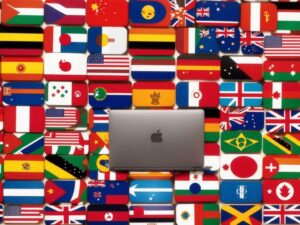The days of being confined by geographical borders are long gone, thanks to the rise of multilingual websites. If you’re wondering how embracing multiple languages on your website can work wonders for your business, then you’re in for a treat. In this article, we’ll embark on an exploration of the tangible benefits a multilingual website can bring to your digital doorstep.
 A multilingual website allows you to address each guest in their preferred language, creating an inclusive atmosphere. This inclusivity doesn’t just attract local customers, it opens the doors to a global market. Your reach extends to regions you may have never considered before, tapping into a goldmine of potential customers. The broader your audience, the greater your chances of growth.
A multilingual website allows you to address each guest in their preferred language, creating an inclusive atmosphere. This inclusivity doesn’t just attract local customers, it opens the doors to a global market. Your reach extends to regions you may have never considered before, tapping into a goldmine of potential customers. The broader your audience, the greater your chances of growth.
Visitors from different parts of the world can navigate your site comfortably, finding information in their native language. This streamlined experience reduces frustration, enhances user engagement, and keeps visitors browsing for longer periods. The longer they stay, the better the chance of converting them into loyal customers.
A multilingual interface tells your audience that you value their language and culture. This effort doesn’t go unnoticed; it establishes trust and credibility, showing that you’re willing to go the extra mile to communicate effectively. In a world where authenticity matters, a multilingual website sets you apart as a business that cares.
Each language has its own set of keywords that users search for. By having a multilingual website, you’re essentially opening multiple doors for search engines to find you. Imagine being at the top of search results not just in your country, but in various countries. It’s like getting front-row seats at a global digital fair, with visitors from every corner eagerly exploring what you have to offer.
In the grand game of business, staying ahead is crucial. A multilingual website gives you that competitive edge, positioning you as a forward-thinking player in your industry. While others might still be thinking about expanding internationally, you’re already engaging with a diverse audience. This proactive approach not only attracts customers but also solidifies your reputation as a brand that understands and respects the global market.
Cultural diversity enriches our world, and acknowledging this diversity is essential in the digital landscape. A multilingual website isn’t just about translating words- it’s about understanding the nuances of each culture and tailoring your message accordingly. By doing so, you’re fostering genuine connections with your audience. It’s like speaking their language not just with words, but with an understanding of their values and preferences.
Let’s talk about typical mistakes that developers make when creating a multilingual site.
The Automatic Translation Trap. Automatic translation tools seem like a magical solution – quick and cost-effective. While these tools can work wonders for day-to-day conversations, they fall flat when it comes to capturing the nuances of your brand’s voice and the intricacies of culture. A direct translation can often result in confusion, misinterpretation, and even unintended humor.
Here’s the antidote: bring in the human element. Enlist the expertise of skilled translators who understand not just the words, but the essence of your message. These language artists can craft content that resonates, capturing the cultural nuances that automatic tools simply miss. Remember, it’s not just about communicating; it’s about connecting.
 One-Size-Fits-All Design. It’s tempting to stick with a universal design template – after all, a layout that works well in one place should work everywhere. But design preferences vary wildly across cultures. Colors, imagery, and even the arrangement of elements can evoke different emotions in different regions.
One-Size-Fits-All Design. It’s tempting to stick with a universal design template – after all, a layout that works well in one place should work everywhere. But design preferences vary wildly across cultures. Colors, imagery, and even the arrangement of elements can evoke different emotions in different regions.
Research the preferences of your target audience and adapt your design to cater to them. A thoughtful choice of colors and images can create an instant connection and resonate with users on a deeper level.
Language Switcher Woes. A misplaced or hidden language switcher can leave users frustrated and heading for the exit.
Make your language switcher prominent and intuitive. Ideally, it should be visible at a glance – perhaps in the top right corner. A well-designed switcher not only guides users smoothly to their language of choice but also shows that you’ve thoughtfully considered their needs.
Lost in Units and Dates. Ignoring the system of units and date formats can lead to confusion and hinder user experience. Before launching your site globally, take a moment to adapt measurements and date formats to suit the preferences of each region. Avoid jargon that might make your audience scratch their heads. Remember, clarity is key when it comes to ensuring a seamless browsing experience.
So, before you hit the launch button, take a step back. Embrace the power of human translation, tailor your design to the palette of cultures, guide users with an intuitive language switcher, and ensure your units and dates speak the same language as your audience. The road to a successful multilingual website might be paved with challenges, but with these insights, you’re well-equipped to create an online space that welcomes visitors from all corners of the globe. Remember, it’s not just about the website – it’s about crafting a bridge of understanding in a digital world that knows no borders. Don’t just limit yourself to one language – unlock the doors to a world of opportunities with a multilingual website.